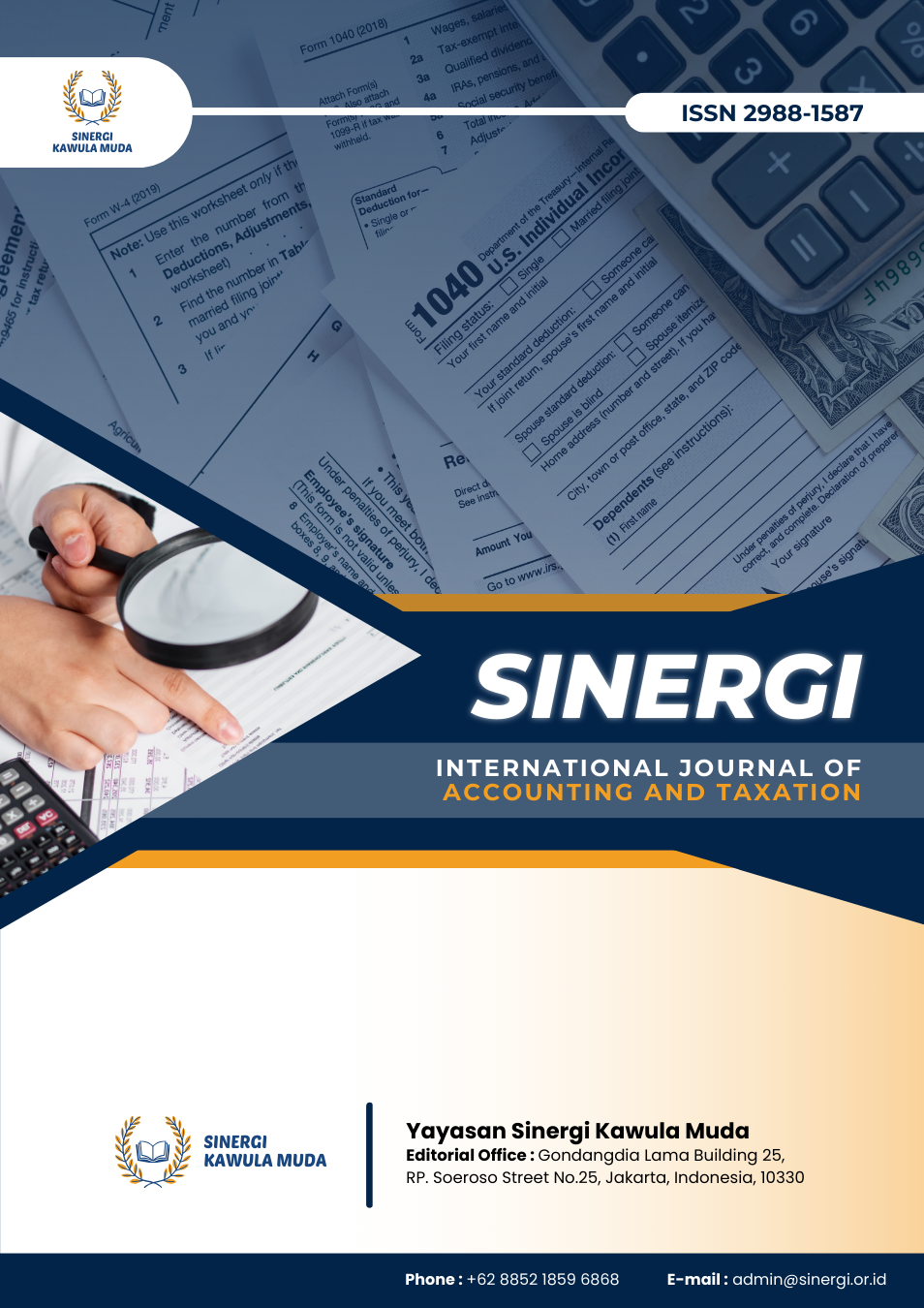The Impact of Income Tax on Economic Growth: Insights from Indonesia
DOI:
https://doi.org/10.61194/ijat.v2i3.639Keywords:
Income Tax, Economic Growth, Investment Climate, Tax Policy, Business Expansion, Fiscal Sustainability, IndonesiaAbstract
This study examines the relationship between income tax policies and economic growth in Indonesia, focusing on their effects on investment, business expansion, and household consumption. While income tax is a fundamental instrument for fiscal revenue, excessive taxation may hinder private sector growth and reduce consumer spending, ultimately affecting overall economic stability. This research employs a mixed-methods approach, combining econometric modeling with qualitative interviews from key stakeholders, including government officials, economists, business owners, and financial consultants. Findings indicate that higher income tax rates can negatively impact investment and corporate expansion, particularly among SMEs. However, tax incentives and compliance enhancements contribute to improved economic activity. The study also highlights the role of digitalization in streamlining tax compliance and increasing government revenues without overburdening businesses. Furthermore, tax policy adjustments, including targeted incentives and simplified tax structures, are essential to balancing fiscal sustainability and economic growth. These findings emphasize the importance of tax policy reforms that foster a business-friendly environment while ensuring adequate government revenue. The study contributes to fiscal policy literature by providing empirical insights and policy recommendations. Future research should examine comparative tax policies in emerging economies and the long-term impact of tax reforms on economic resilience
References
Acosta-Ormaechea, S., & Morozumi, A. (2019). The composition of government spending and the fiscal multiplier. Journal of Monetary Economics, 105, 1–19. https://doi.org/10.1016/j.jmoneco.2018.08.007 DOI: https://doi.org/10.1016/j.jmoneco.2018.08.007
Appiah-Kubi, J., Oduro, I., & Owusu, A. G. (2021). Tax incentives and foreign direct investment: Evidence from Sub-Saharan Africa. International Journal of Finance & Economics, 26(4), 5141–5155. https://doi.org/10.1002/ijfe.2032 DOI: https://doi.org/10.1002/ijfe.2032
Gemmell, N., Kneller, R., & Sanz, I. (2014). The growth effects of tax rates in the OECD. The Economic Journal, 124(576), 905–938. https://doi.org/10.1111/ecoj.12058 DOI: https://doi.org/10.1111/ecoj.12058
Grace, M., Salim, R., & Wahyuni, S. (2023). The short- and long-term impacts of tax amnesty on revenue collection: Evidence from Indonesia. Asian Economic Journal, 37(1), 72–91. https://doi.org/10.1111/asej.12267 DOI: https://doi.org/10.1111/asej.12267
McNabb, K. (2018). Tax structures and economic growth: New evidence from the government revenue dataset. Journal of International Development, 30(2), 173–205. https://doi.org/10.1002/jid.3345 DOI: https://doi.org/10.1002/jid.3345
Milasi, S., & Waldmann, R. (2017). Top income tax rates and the economic performance: Cross-country evidence. Applied Economics Letters, 24(18), 1320–1325. https://doi.org/10.1080/13504851.2016.1270412 DOI: https://doi.org/10.1080/13504851.2016.1270412
Moshiri, S., & Daneshmand, A. (2020). Tax evasion, complexity, and compliance costs in developing countries. International Journal of Public Administration, 43(9), 786–798. https://doi.org/10.1080/01900692.2019.1645691 DOI: https://doi.org/10.1080/01900692.2019.1645691
Mustapha, A. M., Ali, M. A., & Kamarudin, K. A. (2024). Fiscal policy effectiveness and economic resilience in Southeast Asia. Economic Modelling, 133, 106020. https://doi.org/10.1016/j.econmod.2024.106020
Omodero, C. O. (2024). Taxation and SMEs’ growth in developing economies: A Nigerian perspective. Small Business Economics, 62(2), 291–309. https://doi.org/10.1007/s11187-024-00765-5
Xu, L., & Wu, H. (2020). Corporate tax competition and investment behavior: Evidence from East Asia. International Review of Economics & Finance, 69, 843–855. https://doi.org/10.1016/j.iref.2020.06.005 DOI: https://doi.org/10.1016/j.iref.2020.06.005
Zidar, O. (2019). Tax cuts for whom? Heterogeneous effects of income tax changes on growth and employment. Journal of Political Economy, 127(3), 1437–1472. https://doi.org/10.1086/701607 DOI: https://doi.org/10.1086/701424
Sayed, Z. B., & Gayathri, J. (2021). Factors Determining the Exchange Rate Exposure of Firms: Evidence From India. Business Perspectives and Research, 11(2), 210–226. https://doi.org/10.1177/22785337211033766 DOI: https://doi.org/10.1177/22785337211033766
Sendy, S., & Basaria, F. T. (2023). A Comparative Analysis of Hazard Analysis Methods for Sustainable Energy Development. E3s Web of Conferences, 388, 01037. https://doi.org/10.1051/e3sconf/202338801037 DOI: https://doi.org/10.1051/e3sconf/202338801037
Sengupta, R., & Gupta, A. S. (2019). Alternate Instruments to Manage the Capital Flow Conundrum: A Study of Selected Asian Economies. Pacific Economic Review, 24(2), 241–268. https://doi.org/10.1111/1468-0106.12296 DOI: https://doi.org/10.1111/1468-0106.12296
Sławik, A., & Bohatkiewicz-Czaicka, J. (2022). Financial Innovation of Mass Destruction—The Story of a Countrywide FX Options Debacle. Risks, 10(2), 28. https://doi.org/10.3390/risks10020028 DOI: https://doi.org/10.3390/risks10020028
Tang, M.-L., Wu, T., & Hung, M.-C. (2022). Optimal Pension Fund Management With Foreign Investment in a Stochastic Environment. Mathematics, 10(14), 2468. https://doi.org/10.3390/math10142468 DOI: https://doi.org/10.3390/math10142468
Yavas, B. F., Dedi, L., & Škrinjarić, T. (2020). Did Equity Returns and Volatilities Change After the 2016 Trump Election Victory? International Journal of Finance & Economics, 27(1), 1291–1308. https://doi.org/10.1002/ijfe.2215 DOI: https://doi.org/10.1002/ijfe.2215
Yudha, J. O. M., Oktavia, R., & Desriani, N. (2023). The Effect of Foreign Debt, Liquidity, Firm Size, and Exchange Rate on Hedging Decision. Journal of Indonesian Economy and Business, 38(2). https://doi.org/10.22146/jieb.v38i2.5887 DOI: https://doi.org/10.22146/jieb.v38i2.5887
Zahedi, J., Salehi, M., & Moradi, M. (2021). Identifying and Classifying the Contributing Factors to Financial Resilience. Foresight, 24(2), 177–194. https://doi.org/10.1108/fs-10-2020-0102 DOI: https://doi.org/10.1108/FS-10-2020-0102
Zhang, Y., Chen, R., & Ma, D. (2020). A weighted and directed perspective of global stock market connectedness: A variance decomposition and GERGM framework. Sustainability (Switzerland), 12(11). https://doi.org/10.3390/su12114605 DOI: https://doi.org/10.3390/su12114605
Downloads
Published
How to Cite
Issue
Section
License
Copyright (c) 2024 Rika Febby Rhamadhani

This work is licensed under a Creative Commons Attribution 4.0 International License.






